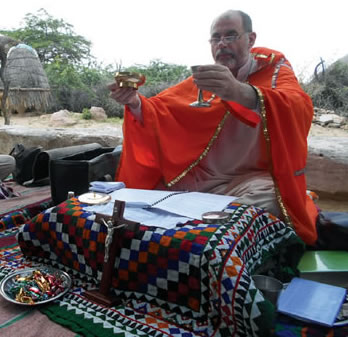
Building a Community
The Parkari Kohlis are one of many tribal peoples in Sindh, Pakistan, who live in an on-going state of liminality; that is geographically, religiously, economically, politically and socially they live on the edge. Even the oppression they endure as bonded laborers leaves them in liminality as their resilience to their present suffering reveals their longing for a better future. Since 1947 they are also a partitioned people. When the partition of the Indian Sub-Continent created two new countries, Pakistan and India, Parkari Kohlis, as a tribal people, found themselves living in two different countries. Their homeland is considered Nagar Parkar, a small town in Thar Parkar Desert just inside the Pakistani side of the border with India in the southern province of Sindh.
Franciscan Fr. Benedict began outreach to the Parkar Kohlis in the Nagar Parkar area in the 1960s from Kunri Parish. This was then a journey of seven days by camel across the Thar Parkar Desert. Today with a jeep and paved roads the journey is five hours. Fr. Benedict bought land in a village that is now called Isai Farm and set up the first Christian community. There was a severe drought in Thar Parkar during the 1960s. The Church got involved in giving emergency aid. This was one reason why some people became Christian. Another reason was sensitivity to inculturation. For example, when Bishop Paul Bonaventure carried out a pastoral visit of Nagar Parkar and all the villages in the 1970s, his team included a bhagat i.e. a religious leader who uses music and song in the traditional Hindu way to transmit the message.

After Fr. Benedict left the mission due to ill health there was a lapse in outreach. Franciscan Fr. Daud also visited Nagar Parkar when he was in Kunri Parish in the late 1970s and early 1980s. When the Columbans came to Badin in 1983, responsibility for Nagar Parkar was transferred from Kunri to Badin which led to a consistent visitation and outreach to people. Sr. Maria Beatrix also started outreach in the mid-1980s, and was later joined by other Sisters from her order. A hostel for high school level boys was also started in the early 1980s, by Master Walji, who was also a catechist. The hostel boys came from the scattered villages and previously attended the government high school in the town. This enabled many young people to receive an education that otherwise would have been very difficult.
In the late 1990s, a three acre plot was purchased by the diocese just at the entrance to the town. In the early 2000s a boundary wall was constructed. On December 6, 2004, Master Ramchand, catechist, and family formally moved into the new compound. At that time Columban Fr. Tony Cavanagh was responsible for outreach to Nagar Parkar so as December 6 is the feast of St. Nicholas, this is the name he chose for the new parish. It is an appropriate name for a parish with a focus on children’s education.
In December 2011, the now Bishop Emeritus Max Rodrigues blessed a new hostel, parish house, catechist’s quarters and boarding master’s quarters. There is a tube-well in the compound which allows for the planting and nurturing of many fruit trees, trees and flowers.
The newly completed church of St. Nicholas was blessed on Friday, April 13, 2018, by Bishop Samson Shukardin. It was a joyous occasion attended by roughly 250 people, 150 from the local community and 100 people, most of whom arrived the night before, including, lay people, catechists, Brothers, Sisters and priests from various parishes in the diocese. The celebration started on Thursday night with singing and dancing to the beat of the drum.
The singing and dancing continued on Friday morning in the procession to the church of all people present. At the beginning of the procession, Bishop Samson was presented with a specially commissioned and decorated saffron shawl, which he wore for the Eucharistic celebration. Saffron is the sacred color in the Hindu tradition.
The blessing and anointing of the alter, tabernacle and church itself was inclusive and participatory when Bishop Samson invited representatives of priests, Sisters, catechists and some local lay people to participate in the anointing. The tabernacle in the new church was transferred from the soon-to-be-sold Columban House in Lahore.
The exterior design and structure of the church is intended to replicate the style of the mud and timber huts that people in the surrounding villages live in. The style of the tiles on the walls in the interior body of the church is unique to Sindh.
In his homily, Bishop Samson thanked all people who had made a contribution to the realizing of a vision of building a Christian community and a church in Nagar Parkar. Special mention was given to Fr. Benedict and all catechists, Sisters and priests who helped build up the community worked in Nagar Parkar throughout the years.
The Christian community in Nagar Parkar is small, roughly 100 families scattered over fifteen or so villages. When there are no rains many people migrate into the interior to harvest the crops, and return if the monsoon rains come in July to plant their crops. It is a precarious and difficult existence. But, as history shows down the centuries, it is on such difficulties that a community is built.
May the new church, the liminal, at the edge space for worship become a place where people are inspired in the words of Micah: “to act justly, love tenderly and walk humbly with their God.”
Columban Fr. Tomas King lives and works in Pakistan.